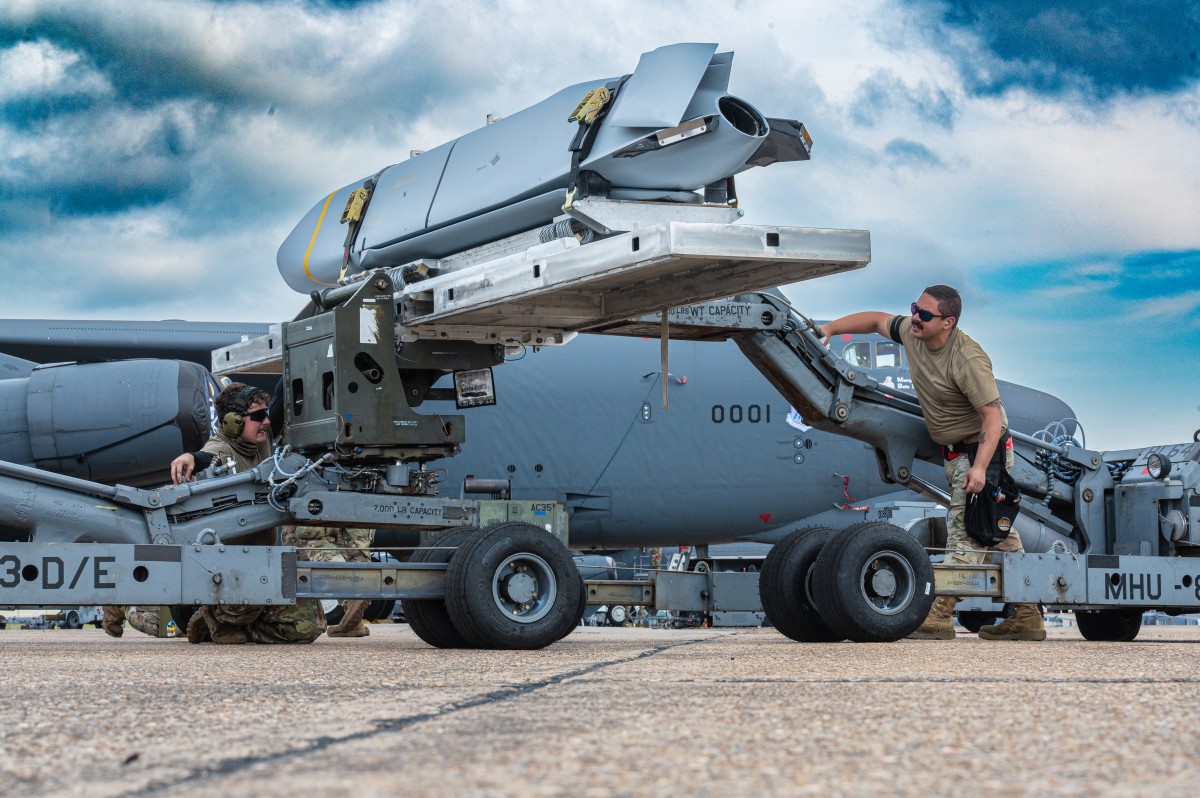In a rare exercise amid continued tensions with China and Russia, the U.S. Air Force’s 2nd Bomb Wing tested its long-range strike capabilities by loading live AGM-158 Joint Air-to-Surface Standoff Missiles (JASSMs) onto B-52H Stratofortresses.
The exercise, part of the broader Exercise Bayou Warrior, was held at Barksdale Air Force Base in Louisiana from June 10 to June 13, 2024.
The largest bomber wing in the U.S. Air Force Global Strike Command (AFGSC)—the 2nd Bomb Wing—loaded the live missiles onto the bombers for a “readiness exercise.”
The significance of the drill was amplified by the use of live munitions, identifiable by a yellow line, unlike the blue line used for inert weapons.
While the JASSMs were not launched during Exercise Bayou Warrior, the activity provided valuable training for personnel in executing conventional strikes with live munitions. Such practice is rare, given the high cost of these missiles, which exceed $1 million each.
The primary objectives of the exercise were logistical and technical, aiming to enhance the ground and maintenance crews’ proficiency in rolling out and loading the missiles onto the large strategic bomber.
The drill aimed to test the wing’s ability to “generate, load, and deliver conventional weapons in a simulated environment,” as described in photo descriptions and official statements.
Wing leadership, including the Crisis Action Team, was actively involved in the exercise, which simulated a real combat deployment scenario. The inspector general’s office of the Air Force Global Strike Command evaluated the weapons loading and maintenance processes during the exercise.
Col. Bryan J. Walter, who previously served as the deputy inspector general for AFGSC and recently took command of the 2nd Operations Group, highlighted the importance of these evaluations.
“They’re going to come in, and they’re going to give you a hard look at, ‘Are you ready to go?'” said Walter. USAF officials stated that the crews would benefit from the scrutiny.
Although the specifics of the simulated combat scenario remain classified, wing officials confirmed that the exercise closely replicated a real-world situation.
U.S. Air Force Advances Strategic Readiness with B-52H Stratofortress and JASSMs
The drill marks a major step in ensuring the readiness and efficiency of the U.S. Air Force’s strategic capabilities, demonstrating its preparedness for potential long-range strike missions with live munitions.
The B-52 has a storied history of deploying a wide array of weapons over its 60-year tenure, maintaining its status as a symbol of UU.S.nuclear strength.

Its primary role, however, has been as a conventional bomber. Its future likely centers on using standoff cruise missiles launched from its bomb bay and expansive wings.
Apart from the recent exercise, previous training events, such as Prairie Vigilance in April, involved crews loading the AGM-86B Air-Launched Cruise Missile (ALCM) onto B-52H bombers stationed at Minot Air Force Base, as reported by the EurAsian Times.
The B-52H can accommodate up to 20 JASSMs, with 12 mounted on the outer pylons of its wings and another eight housed internally.

The capability to release a JASSM from an internal Conventional Rotary Launcher (CRL) was a notable advance first demonstrated in August 2016, further enhancing the B-52H’s operational versatility and strategic efficacy.
Preparing the B-52H for simulated combat is a formidable task, akin to preparing a team for a “playoff game”. The sheer size of the bomber necessitates specific operational considerations, with most hangars unable to accommodate it, resulting in B-52s lining the ramp at Barksdale.
U.S. Air Force data indicates that slightly over half of the B-52 fleet is “mission capable” at any given time, underscoring the logistical challenges and meticulous maintenance required to ensure operational readiness.
Master Sgt. Nickolas Shelton, production superintendent with the 2nd Aircraft Maintenance Squadron, highlighted the dedication and skill of maintenance personnel: “It’s a very old aircraft. It’s a lot of work, but our guys are great at their job. It’s about time management, people management, parts management. It’s nothing to worry about. The airplane’s going to make a decision on if it breaks or not. We just fix it.”
While the U.S. Air Force conducts routine exercises to enhance operational processes, opportunities to train with high-end weapons like JASSMs are rare. Loading live JASSMs onto a B-52H, as was done during Exercise Bayou Warrior, provides invaluable hands-on experience and enhances operational readiness.
Capt. Timothy Walraven, a weapon systems officer with the 20th Bomb Squadron who has experience in live-fire JASSM tests, noted the rarity of flying with JASSMs mounted on the pylons.
This presents a significant opportunity for aircrew to improve their proficiency. Compared to simulated training scenarios, it provides a clearer view of real-world conditions, ensuring readiness for any operational deployment.
- Contact the author at ashishmichel(at)gmail.com
- Follow EurAsian Times on Google News




